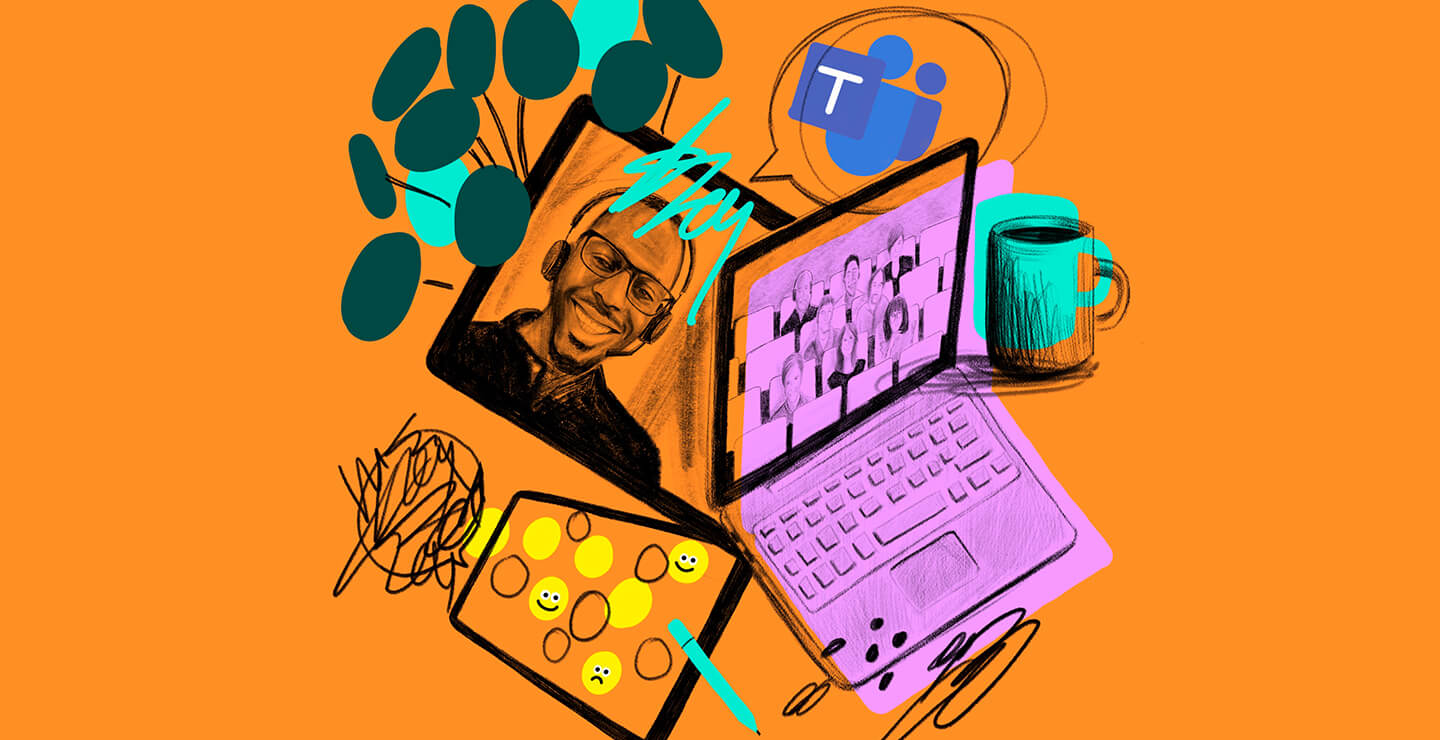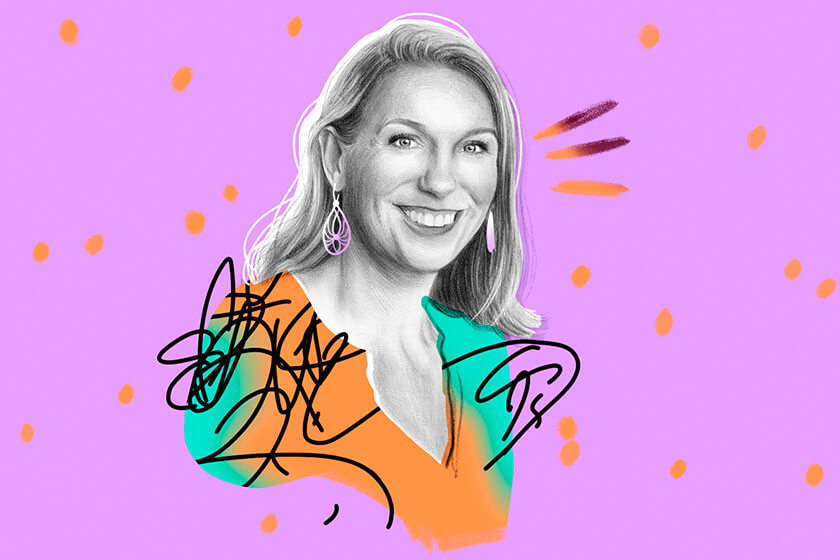
W ork friendships are among the most rewarding relationships people make, but many have been transformed—and tested—in the age of COVID-19. How can companies encourage spontaneous, getting-to-know-you conversations among remote or hybrid teams? How can teammates maintain genuine connections over video calls? For Microsoft and its researchers, these questions are top of mind; the company created Together mode—a form of video chat for Microsoft Teams—to replicate the conviviality of gathering in person.
To learn more about friendships among colleagues, WorkLab reached out to Marissa King, a professor of organizational behavior at the Yale School of Management who studies social connections, including in the workplace. In her new book, Social Chemistry: Decoding the Patterns of Human Connection , King reveals how humans form these intricate relationships and how they impact our lives and livelihoods. Colette Stallbaumer, General Manager, Future of Work, spoke to King about the advantages of having a good work friend or two, and about how companies can help rebuild social ties that have frayed during all-remote work. (This interview has been condensed and edited for clarity.)
Colette Stallbaumer: At Microsoft, we’re deeply invested in the topic of social capital; we’re always studying and thinking about workplace dynamics when we design new tools. So first off, how do friendships in the workplace benefit people and the organizations they work for? What does the research say?
Marissa King: The research is pretty clear that workplace friendships have enormous benefits. Having social support from coworkers reduces stress, helps reduce burnout, improves efficiency and productivity, and increases employee engagement. If you think about many of the challenges that companies are facing around engagement and retention, these relationships are really critical. But when we think about workplace friendships, oftentimes people think those effects arise from having a lot of friends at work, or from the everyday positive interactions that we have on a momentary basis, like bumping into people at the watercooler. And that’s certainly true. But the vast majority of these benefits come from your close friends at work. If you’re looking at what the real effects are in terms of efficiency, job satisfaction, even the likelihood of accidents happening at the workplace, those primarily come from whether you have a close friend at work, not just having lots of friendships.
Our CEO, Satya Nadella, has spoken a fair amount during the pandemic about how we are eroding the social capital that has been built up over decades around watercoolers and in cafeterias and conference rooms. Are you seeing that?
What appears to be happening is that the outer reaches of our networks, those casual acquaintances, have shrunk, and we’re now focusing on our closest connections. This is true in our personal lives and at work. Research by Ethan Bernstein at Harvard has found that post-pandemic interactions among close team members increased by 40 percent, but that was at the expense of more casual acquaintances, which are really suffering.
“Having social support from coworkers reduces stress, helps reduce burnout, improves efficiency and productivity, and increases employee engagement.”
There really isn’t a “one-size-fits-all” solution to this. We need to recognize that employees are really heterogeneous in what they need from their relationships and how they form them. Some people are happy having their colleagues over for barbecues, for example, while others really like to keep their home and work life separate.
Are there strategies that are comfortable for both but that still allow for innovation and creativity to flourish? Especially since research shows that “weak ties”—connections with people on the outer rings of our network—bring us novel information that helps us innovate.
One of the most effective ways is bringing people into purposeful conversation about ideas they may not normally be talking about. Rather than trying to force conversations as part of a random coffee chat, you create an event where there’s a common goal or purpose, where people can discuss something that may be totally unrelated to work, like art. You’re allowing people to come together in ways where they can show different ways of thinking and start to connect with one another, but the point is very much around innovation and creativity—it’s not just trying to foster social interaction for its own sake.

Marissa King is the author of Social Chemistry: Decoding the Patterns of Human Connection.
Illustration by Jordan Andrew Carter
It takes a little more effort to create these reasons for coming together during the pandemic, but the return on investment on these types of engagements—even virtually—is worth it. Shifting gears, though, to ask about something from your book: Why can it be challenging to make and keep friends at work?
Work friendships are oftentimes difficult because they can be both emotionally exhausting and create a sense of obligation. Jessica Methot at Rutgers did some great work on this. She studied a variety of different industries and found that our relationships at work are really, really fragile, in part because they create this sense of obligation, and they can be exhausting because they create competing demands. Ultimately, our friendships are centered around values like community and togetherness, but work is really about instrumental relationships and money. So it’s hard, right? Because money and friendship just simply don’t mix. Even if you’re not necessarily thinking from an instrumental perspective at work, it’s just embedded in that atmosphere.
“There’s a good body of research that shows that women are much more likely to keep their work relationships and their personal relationships separate.”
In your book, you write about the difficulties that women and minorities face navigating work relationships. What can be done about that?
There’s a good body of research that shows that women are much more likely to keep their work relationships and their personal relationships separate. And this has lots of advantages, like creating much more work-life balance. But that means women need to network twice as hard as men to build work relationships, because they’re not working and hanging out at the same time. And that same idea impacts minorities as well. There’s an article by Kathy Phillips, Tracy Dumas, and Nancy Rothbard called “Getting Closer at the Company Party,” where they found that minorities are equally likely to show up for these types of events, but they don’t leave them feeling any closer to anyone else from the party, because they don’t feel as comfortable talking about their whole lives at these parties. They’re really attending out of a sense of obligation. The solution is to create environments where everybody can feel authentic, where they can show up and be their authentic selves.
Looking forward to life post-COVID, what can people and companies do to rebuild relationships and social networks that might have been frayed by the lockdown?
One of the things that’s promising for me looking forward is that relationships are extraordinarily resilient. Trust, in particular, tends to stay for a long time. And so just being able to recognize that and tapping into it. You don’t really need to rebuild everything from the ground up. Instead, rebuilding on what already exists is going to be a much easier and much more powerful way forward.

